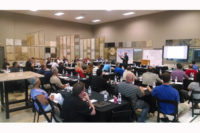Fabricators helping fabricators. That’s what Fabricator Forums are all about, and the one held during StonExpo – part of The International Surface Event – which took place at the Mandalay Convention Center in January was no different. Moderated by Duane Naquin of Stone Interiors in Gaston, SC, and including a panel of Marco Duran of Atlas Marble & Granite in Springfield, NJ, and Buddy Ontra of Ontra Stone Concepts in Bridgeport, CT, the hour-long session drew a crowd of industry professionals who came ready to learn from each other and share their own experiences.
Cyber security
Part of what makes these forums so successful is the openness and no set pre-agenda. Naquin started out by asking participants what was on their mind and some topics they would like to cover. The first issue that was addressed was cyber security – a subject that all business owners might not consider.
“Two-and-a-half years ago, we got hit hard,” explained Naquin. “Our entire payroll and accounts were wiped out, and we were employing a reputable IT company. They were a big company. They set us up originally, but never came and sat down with us and looked into our files. They were backing up the wrong folder.”
Naquin instructed the audience to look at email filters. “They say only about 15% of companies survive an attack like [we did].”
Duran also shared his personal experience. “I was also hit,” he said. “It was like out of a movie. We received a cryptic email. It said you have to give us three bitcoins. Our IT [company] said for us to shut everything down. Ultimately, it was tracked to Russia. After that, we now backup multiple times.
“Have a backup plan,” he went on to say. “Have someone else, maybe your accountant, keep a storage too.”
Ontra told his fellow fabricators that his company only has three computers, which they backup every 24 hours.
Procedures for working in cities
Moving on, one participant asked for tips about working in large cities. “Logistics are very important,” Duran, who often installs jobs in New York City, told the fabricator. “Make a list of all the pitfalls. Document what went wrong and get better at what you do.
“Right from the start, we do a pre-check the day before,” Duran went on to say. “We make sure from administration and scheduling that everything is set. The rule is that everyone is at the shop at 6 a.m. and we are out the door at 6:30 a.m. When we need extended time, we work with a general contractor to make sure we can leave a job box.”
Duran explained that the driver pulls up and the crew off loads. “The driver waits to get the word that everything is good, and then they drive away and come back later. We have two retirees to help. My recommendation is to plan, plan, plan. Expect the worst, but hope for the best. And the best way to get on the building [management’s] good side is to respect their rules.”
Finding and retaining employees
Another topic that arose, which often does at sessions such as this one, is how to find and retain quality employees. “I used to ask my present employees to bring people in, but I did have an incident,” said Ontra. “One of my top employees asked to bring in his younger brother, but then he refused to teach him. I have had success with people bringing people from their social network, but not everyone is teachable though.”
Ontra also suggested reaching out to vocational schools in the area. “It hasn’t happened yet, but I will have one to two students come over from masonry or wood departments every Wednesday and shadow our workers,” he explained. “I’m going to see how that works out.”
Duran explained to the group that he has been in business for 17 years and every year is a new strategy. “Last year, I started thinking about retaining employees, the culture of the business and the word of mouth from within,” he said. “It’s about staying and recruiting. What’s going to entice people? What are you offering them? I looked into other industries to see what they are doing. I’m very descriptive when I put out a post. I use imagery.
“Last year, we changed our cash flow and invested in our employees,” Duran went on to say. “We embarked on a 401K program. It’s been very successful. I match it. It’s about making people feel like there is a future in this company. We also offer healthcare. That’s always on people’s mind. For those with families, that’s an attractive sale. When we asked people, wage wasn’t always at the top of the list. People want security.”
Naquin explained that his company has been using a lot of temporary services. “We bring them in and work them for two or three months to see how they do.”
Jumping in on the subject, Ontra said, “Younger people think differently than I do. Today, they want experience. When I got a job when I was 22, I did everything I possibly could to keep it. [Most of this generation] doesn’t care. They’ll leave and go get a different job. I’m not knocking them. I’m not saying, ‘we have to accommodate them,’ but we do have to change.”
Tracking mistakes
Changing the subject, a fabricator in the audience asked how many mistakes do shop workers make in a week?
“It’s about tracking and honing down where the mistakes are,” said Duran. “It can start with sales or measuring. We measure by department. If sales are going to give information, they better get the right information.
“We incentivize our managers to report everything,” Duran went on to say. “In terms of mistakes, we try to keep it under about 5% -- that’s across the board. One of my clichés is: ‘Good morning, boys. What’s it going to be today?’ I’ll give you 100% of your pay, but you have to give me 100% of your work. I’m trying to infuse in them that if you give me 80% than take a look at your paycheck. You don’t want to be negative though.”
Someone in the audience asked, “When do you get signatures? How pushy do you get with customers?”
Naquin said that he lets the end-user make the final decision on seams and edges. “Email conversations are great to document things, but terrible for communication,” he said. “It drives me nuts because half of my sales people don’t want to pick up the phone and talk to people. They hide from voice interaction. We push to pick up the phone and have a conversation first. Then send a follow-up email and confirm everything. To actually reach out and have that interaction is so much easier to explain things.”
Effective training methods
Another participant asked, “What is the most effective way to train your team?”
“I use some of the Natural Stone Institute documents,” said Ontra. “All of them are available online. You can tailor them to your own needs.”
“We also service Big Box,” said Duran. “There are safety steps you have provide. We follow best practices. We have our own internal safety program. We work with consultants and have our own books on what we do. It satisfies the Big Box.”
“When you talk about training, there’s safety, sales, etc.,” said Naquin. “It’s not a one-time thing. You can’t train an employee the first day and set him loose and think everything is going to be okay. We have to review the basics. It’s usually dumb mistakes – something they should have known. We are constantly re-educating and reinforcing. We do it on a quarterly basis -- every quarter. We want to make sure we are all on the same page again. It’s important to constantly reinforce training and procedures you have in place.”









